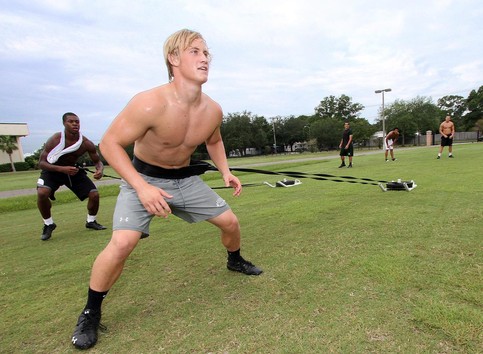
Even the traditional summer workouts have changed. At Tampa Catholic, veteran Crusaders coach Bob Henriquez hired athletic training guru Josh Cooper of the Tampa-based Cooper Speed-Strength School. Cooper has aided numerous pro athletes, like baseball’s Aubrey Huff and Pat Burrell, and is working with former local football stars like Andre Caldwell and Jarred Fayson, who are preparing for the NFL season.
Full Article Below:
Not too long ago, summer training for high school football players usually meant occasional trips to the school’s weight room, some jogging now and then and, maybe, tossing the ball around at the beach.
But that was before Armwood, Plant and, most recently, Jefferson brought home state championships and turned Hillsborough County into one of the state’s hottest recruiting areas.
Today, the work being done during the summer by prep teams often resembles that of a college program. There’s specialized strength training, speed, power, agility and conditioning programs, testing combines and, in a more recent development, 7-on-7 competitions where trips to out-of-state championships and live television appearances are on the line.
Hillsborough coach Earl Garcia, arguably one of the coaches who kick-started the trend of year-round conditioning because of the success his program achieved in the 1990s, has watched prep football change dramatically during his four decades in the sport. And although Garcia recently hired one of the area’s few full-time strength and conditioning coaches, Gabriel Naspinsky, he’s not particularly fond of the “collegification” of prep football, particularly during the summer months.
“I’m not sure I like the direction high school football is going with the combines and the 7-on-7s, the Internets and the Rivals(.com) and the ratings like ‘156th best left guard in Florida,’ ” Garcia said. “It makes you wonder how kids got scholarships and played football before all this.
“But if you go to the beach and don’t do this, you don’t have anybody to coach. All the kids have transferred out so they can go play somewhere else where they get to go to Boca Raton, St. Louis and Peoria, Ill., to play in these (7-on-7) games and they don’t realize that’s not football.”
But like other forms of summer training, 7-on-7 appears to be permanent fixture. And one of the main reasons is not only allowing teams to practice and defend pass routes, but also for the relationships and attitudes players can forge, particularly during high-stakes tournaments.
Since winning its first of three state crowns in 2006, Plant High has been at the forefront of 7-on-7 football, traveling as far as Beaverton, Ore., for a nationally televised game on ESPN. This summer, the Panthers have won two 7-on-7 events, including one that was broadcasted live locally.
Plant coach Robert Weiner says summer 7-on-7 football has allowed his players to learn about one another and gain confidence.
“One reason we come to (7-on-7 competitions) is we want to cultivate a championship attitude and the only way you do that is to play teams like Armwood in these things and get to the semifinals and get to the finals and then you’re playing for the championship,” Weiner said. “So they understand what it is to win a championship.”
Even the traditional summer workouts have changed. At Tampa Catholic, veteran Crusaders coach Bob Henriquez hired athletic training guru Josh Cooper of the Tampa-based Cooper Speed-Strength School. Cooper has aided numerous pro athletes, like baseball’s Aubrey Huff and Pat Burrell, and is working with former local football stars like Andre Caldwell and Jarred Fayson, who are preparing for the NFL season.
Henriquez said several of his players were already going to Cooper’s facility for individualized training when he pitched the idea of Cooper and his staff coming to Tampa Catholic to train the entire squad this summer. During a nine-week course, TC football players are participating in speed, agility and power drills, as well as weight lifting and endurance training.
Henriquez says he has already seen big gains for his players. Cooper says that’s typical of prep athletes compared to pros.
“There’s a bigger window of adaptation,” Cooper said. “So these (prep) athletes, over the course of the summer, are probably going to see anywhere from a tenth (of a second) to three tenths off a 40-yard sprint (time), versus a professional athlete, where if you get a half of a tenth to a quarter of a tenth, you’ve made a good improvement over a summer.”
Armwood coach Sean Callahan says he and his staff are always looking to learn new training methods but the basis of Hawks football, he says, is the weight room. Getting “bigger, stronger, faster,” Callahan says, has always been Armwood’s edge. And while he believes there are things to be gained in 7-on-7 football, Callahan prefers events like the recent 11-on-11 camp his squad attended at the University of Central Florida, where teams played non-tackle scrimmages in helmets and shoulder pads.
Callahan prefers to keep most of his team’s summer training in-house and on campus, away from the influences of coaches, parents and players from outside the Armwood family.
“I know how influential grown men can be,” Callahan said. “A good coaching staff will teach players the right way to do things. Our kids don’t need all those other influences out there that you might find at some of these 7-on-7 tournaments, or at some trainers that can sometimes teach them the wrong way.”
At Hillsborough, Naspinski, who was a strength and conditioning coach at George Mason University and American University, has been focusing on many of the same things as Cooper, including injury prevention. With prep football having evolved into a year-round sport, Naspinski says there’s little time for an “off-season.” As a result, the better athletes — the ones who are seeking college scholarships — are training year-round.
“This (training) is all trying to help them get better as players and to keep them healthy,” Naspinski said. “Once the kids realize that, and that this might eventually lead to them getting a good scholarship somewhere, it’s pretty easy to get them to buy into this type of year-round work.”
Written by Bill Ward


